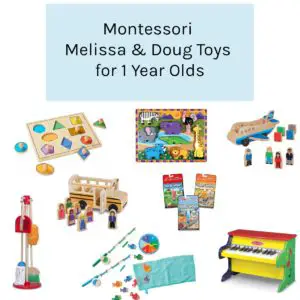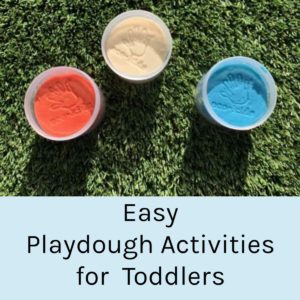

Note: This post may contain affiliate links. What does this mean?
Playdough is such a great “toy” for toddlers. If you have playdough in your house, you can entertain your toddler for hours!
Playdough is a great sensory activity for toddlers. It primarily engages the touch sensory, but also the smell sensory (most brands of playdough have some type of scent to them). Playing with playdough helps strengthen your toddler’s fine motor skills. The act of squeezing the playdough helps strengthen the fingers and hands – which helps set the foundation for building other skills like writing.
If you’re feeling stuck or un-inspired, we put together a list of 15 tried and true playdough activities for toddlers. These playdough activities don’t involve a bunch of outside materials or require much pre-planning and set up. As anyone with toddlers knows, attention spans may be short so we personally don’t like investing a lot of time into setting up toddler activities. Keeping it simple is a common theme of our recommendations. No need to go overboard with playdough activities – sometimes all you need to capture your toddler’s attention is to just present the materials in a slightly different way.
In terms of the actual playdough itself, we personally buy and use “Eco-Dough”. There are tons of great recipes online (if you’re into making your own). Etsy is also a great resource for finding homemade playdough. Then of course there’s the famous “Play Doh” brand of playdough in their signature yellow tubs. Although it’s not our first choice, it’s by far the most budget-friendly!
Rule number one: KEEP IT SIMPLE! Just hand over the playdough to your child and let their instinct kick in. Toddlers have such an inquisitive and explorative nature. Sometimes freeplay with playdough may be short lived or it could last for an hour.
This is where we usually start when playing with playdough with our child. We typically only provide one color of playdough, but sometimes we provide multiple knowing that the colors will get mixed up. Providing two or more colors also tends to keep our toddler’s interest longer.
Once our toddler’s interest in the playdough seems to be waning, we will introduce some of the other playdough activities mentioned below.
If you child has a favorite character, you can engage their interest by making renditions of that character. In our house, for instance, we often make Elmo. The beauty of this is that you can make it as realtistic or abstract as you want. Your toddler will likely be happy either way. In our house Elmo looks vastly different when Mommy vs. Daddy makes the character. You can make it more of a hand-on activity for you child by having them help make the characters (putting on the eyes, nose, etc.) or asking what else needs added.
Make people, a bed, a car…you get the gist! No need for your renditions to be remotley accurate. Hand it over to your child and see what they do with the objects you’ve made!
In conjunction with the previous suggestion, if you want to take it a step further, make up and tell stories using your objects.
Making balls out of playdough is a simple playdough activity you can propose to your toddler. Or just start making them yourself and see if they follow suit or come up with other creative ways to use the playdough balls. Depending on where your toddler is developmentally, the act of making playdough balls could be quite the challenge!
We always try to incorprate math into our activities. Point to and count aloud the balls or other objects you’ve made out of playdough.
Offer a couple dried beans or pieces of pasta (like penne, farfalle, etc.) and let your child stick them in the playdough.
Pro tip: Don’t leave the beans/pasta in the playdough when you go to put it away. You’re asking for mold (ask us how we know).
There are so many other objects you can offer your child in conjunction with playdough. We love the idea of offering big googly eyes and feathers so they can make a monster or creature. But frankly, if you don’t want to run to the craft store, household objects like pen caps, drink lids will work just as well.
This is great to help build letter recognition. Making the first letter of your child’s name or the ABC’s is a good place to start.
If you have a car or train lover, you child will probably enjoy driving their car/train through some flattened playdough.
Have your child sort their creations (or balls) by color. If your child is too young to perform this task you can do it yourself while identifying the different colors with them.
Though too young to likely completely grasp the concept of color-mixing to make new colors, your child will surely be mesmerized watching you take two different colors of playdough and kneed them together to make another color! Another great way to get talking about colors!
If you have cookie cutter available, use it to cut our shapes in your playdough.
If you’re prepared for your playdough to get a little dirty, why not take it outside? Presenting the playdough in a new environment can breath new life and provide many hours more of entertainment. You child can make imprints of the bumpy pavement or other natural objects. They can stick in leaves or rocks – or decorate a rock! The possibilities are endless.
Make two eyes and a mouth. You can use this activity to talk about emotions. Make a happy face and sad face.
Roll out a large piece of playdough and help your child imprint their hand or foot!
Take any small objects you have (toys, plastic drink lid, etc.) and hide it in a big ball of playdough. Have your child uncover it!
Roll up balls of playdough and place them in plastic Easter eggs for an egg hunt. The egg hunt is the star of the show here, but having playdough hidden inside is a simple filler.